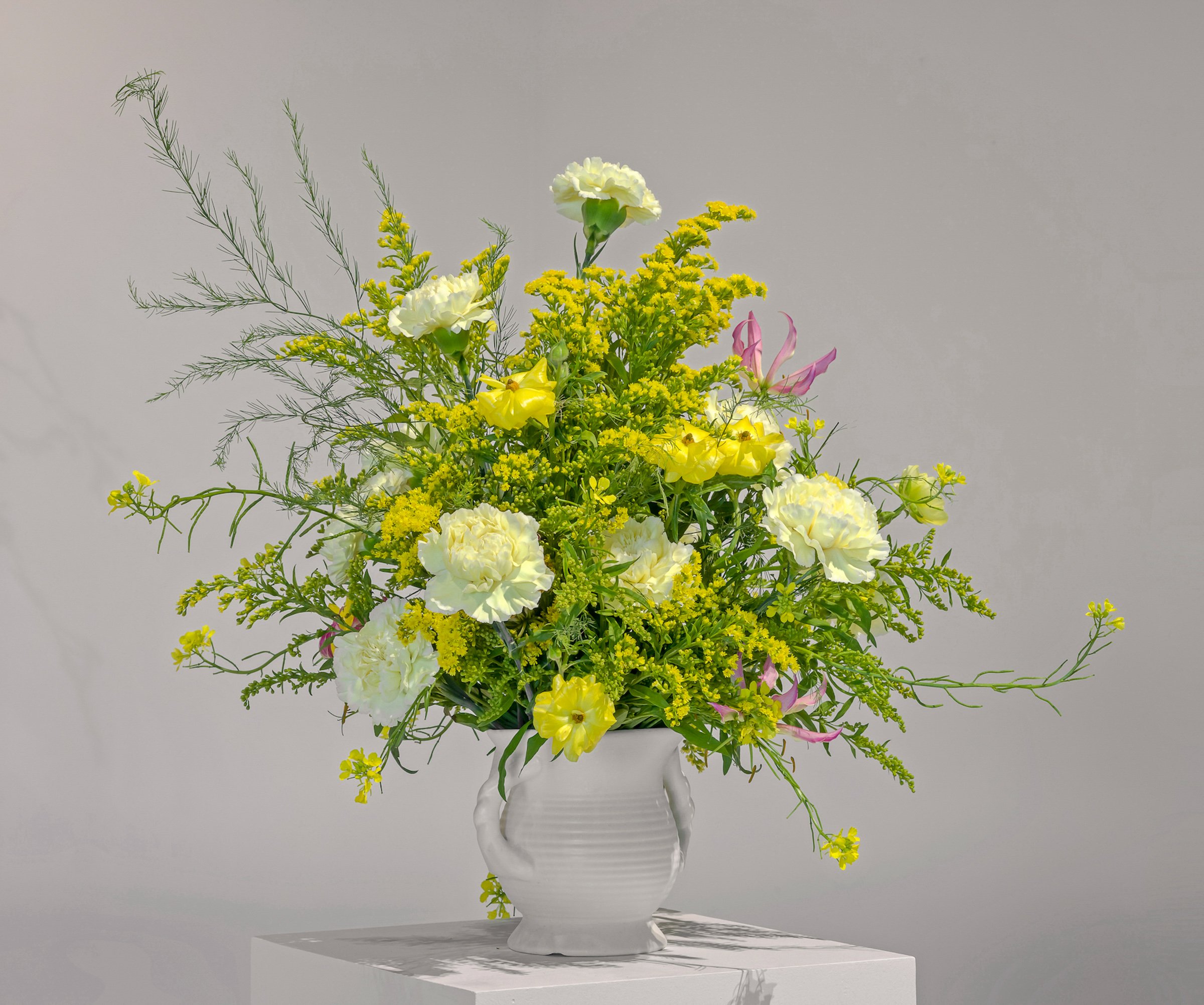Fauna and the Vitality of Nonhuman Bodies
by Margaryta Golovchenko
Kapwani Kiwanga, Flowers for Africa, ongoing, installation view, MOCA Toronto. Protocol of assembly and display including archival iconography to guide the reconstruction of a floral arrangement consisting of cut flowers. Courtesy of the artist and Galerie Poggi, Paris. Photo by Toni Hafkenscheid.
I almost missed Kapwani Kiwangaʼs Flowers for Africa, despite coming to the Museum of Contemporary Art in Toronto deliberately to see it. The three-work, jewel box of an installation was tucked off to the side of the entrance to Toronto’s Museum of Contemporary Art and lacked the standard large expository text announcing an exhibition’s presence like a neon sign. Consisting of three pieces — Cameroon (2020), Angola (2020), and Uganda (2014) — Flowers for Africa was free for all to come in and see but still, it was more a project one must seek rather than passively find.
It’s a similarly subtle visual unobtrusiveness that, perhaps paradoxically, draws Kiwanga to the flower arrangements created for diplomatic negotiations over the independence of various African nations that inspire Flowers for Africa. She has commented, “these flower arrangements are not the centrepiece of what’s happening. They are décor in the background, peripheral somehow; although they are important in creating the atmosphere of officiality when passing over power.” For the artist, the arrangements exemplify “those things that may have fallen through the cracks; everyday experiences of larger events, the invisible, the unseen.” [1]
As elevated on eye-level plinths, Flowers for Africa: Cameroon and Flowers for Africa: Angola command attention while assuming the preciousness we associate with the museum object. At one point, I caught myself wanting to inch my mask down ever so slightly to smell each arrangement, curious how they might differ. COVID-19 protocols aside, I wondered if I ought, instead, to treat these flowers like artworks and not come too close. Should their familiar, almost “everyday” materials preclude them from the dumbstruck reverence I have occasionally felt when standing in front of a work previously only seen in textbooks? Kiwanga offers a subversive invitation to such musings. Not only are the flowers meant to wilt over the course of the exhibition, but they are also open to their environment, with no glass case standing between the slowly wilting petals and the occasional curious hand.
Kapwani Kiwanga, Flowers for Africa: Uganda, 2014, installation view, MOCA Toronto. Protocol of assembly and display including archival iconography to guide the reconstruction of a floral arrangement consisting of cut flowers. Collection Thibault Poutrel. Courtesy of the artist and Galerie Poggi, Paris. Photo by Toni Hafkenscheid.
The ephemerality of Kiwanga’s project evokes Elaine Scarryʼs notion of the “imagined object”: the mental construct we create based on recollection suffused with imagination when the real, “perceived object” is beyond the reach of our senses. We tend to assume that the imaginary object is superior to the real because the imagination is more boundless than our limited senses. However, Scarry argues, the imagined object inevitably disappoints, “lack[ing] the vitality and vivacity of the perceived object.” [2] The imagined objects of Kiwanga’s Flowers for Africa diverge even further from their perceived counterparts. The “protocols” — or instructions — the artist provides her collaborating florists are ambiguous and open-ended. Faced with the same task to re-create, to the best of their ability, what they see in the archival photos, two different florists will likely produce two different results. Subjective perception, interpretation, and judgment come into play, especially in deciding how to fill in portions of the arrangement not captured in the original images. Addressing such gaps inevitably requires the imagination, complete with its vaunted promises and attested shortcomings. However, the flower arrangements of Flowers for Africa are not the only imagined objects here; so too are the political events, borders, and power dynamics to which the works’ histories allude.
Kapwani Kiwanga, Flowers for Africa: Angola, 2020, installation view, MOCA Toronto. Protocol of assembly and display including archival iconography to guide the reconstruction of a floral arrangement consisting of cut flowers. Private collection of Eugene Fu. Courtesy of the artist and Galerie Poggi, Paris. Photo by Toni Hafkenscheid.
Kiwanga trained in anthropology and comparative religion, and research continues to be a vital part of her creative process. Although Kiwanga makes a point of working with florists based in the country represented by each work, it is unclear whether the flowers themselves are original to the region or introduced and initially cultivated by colonial forces. For example, early twentieth century Belgian missionaries imported the eucalyptus found in Flowers for Africa: Rwanda (2019), another work in the series (the artist aims to create fifty-four arrangements in the series; to date, she has completed sixteen). The inability to clearly differentiate between native and settler flower types complicates thinking about nature and nation, substituting cross-pollination on a cultural level for strict and unchanging categories. Such thinking presents new starting points or, in Kiwangaʼs words, “exit strategies” for imagining a pan-African future against our current postcolonial Anthropocene present.
Several other exhibitions this year touched on a combination of flowers, empire, and sensorial experience — Eve Tagnyʼs installation English Rose, part of the MOMENTA Biennale de l’image in Montreal, and the group exhibition You sit in a Garden at Critical Distance in Toronto come to mind. Yet it’s in the work of T.M. Glass, shown recently as part of the 2019 Scotiabank CONTACT Photography Festival, that I find the most resonance with Kiwangaʼs project. The 2019 presentations at OCAD University’s Onsite Gallery, The Audible Language of Flowers, and Galerie de Bellefeuille featured the artist’s hyperreal depictions of flowers from locations as far afield as Glass’s own garden and the Royal Lodge, Windsor Great Park, placed inside vases sourced from collections including the Royal Ontario Museum and the Jardins de Métis.
T.M. Glass: The Audible Language of Flowers, 2019, installation view, Onsite Gallery, OCAD University, Toronto. Photo: Yuula Benivolski.
Kiwanga’s and Glass’s projects both address the topic of value. In Flowers for Africa, questions of display and preservation open up an expansive conversation about the history and longevity of empires. Glass’s work is, quite literally, about the untouchability of certain objects within Western society. In a statement on her website, the artist explains that the museum curators with whom she worked on several of her photographic series “allowed me to photograph vessels from the museum collections. I was not allowed to touch the vessels or put flowers in them. That meant I had to do two photoshoots: one at the museum and the other in my garden. I used digital paint to merge the photographs, and work with the digital paint to create the final painting.” [3] In addition to these collaged and digitally manipulated images, The Audible Language of Flowers featured 3D-printed sculptures Glass created based on some of her photographs of floral arrangements. The plastic used in 3D printing, as scientists continue to remind us, does not decompose easily, and with their pointed use of this material, Glass’s sculptures speak to the inability of letting go of the ephemeral and beautiful, a resistance to the limits of the flower as a living organism. Placed behind glass, they are removed from and exist outside of time, whereas Kiwangaʼs flowers are undeniably present, reliant on context, and speak to the vicissitudes and contingencies of global history and our earthly laws of time and perception.
This hierarchy of preciousness brings us back to Kiwangaʼs interest in documentation and the ephemeral. Through her practice, she contemplates what we consider a document capable of retaining, its role in prolonging memory, and questions about what exactly is being preserved — the memory itself or its mediated, second-hand reflection in this form of retaining and transmission. Kiwangaʼs approach to display disturbs the Western preoccupation with safeguarding art and prolonging its existence, including in the memories and imagination of spectators. Glass’s photographs, in contrast, ultimately heel to the colonial museum and its practices, especially the museum’s desire to accumulate objects. They also recall the dance between beauty and value that, historically, drove art collectors fixated on the untouched and hyperreal object as both the standard and the most desirable commodity. Glassʼs flowers achieve beauty because they are eternally fresh, and with such beauty they become, according to Scarry, a prominent, even perfect, type of imagined object. “Why do flowers so often come to be taken as the representative object of imagining?” she asks. “It may be because, of all objects in the world, they are most beautiful.”
T.M. Glass: The Audible Language of Flowers, 2019, installation view, Onsite Gallery, OCAD University, Toronto. Photo: Yuula Benivolski.
One final component of Glass’s The Audible Language of Flowers was a video work, Phantasia (2019), that records the “speech” of plants as electromagnetic vibrations captured by electrodes attached to their leaves. On the other hand, the oral testimony provided by Kiwangaʼs arrangements, as the descendants of those silent witnesses to political meetings heralding the independence of African countries, permeates historical periods and bridges cultures by means of an adaptive reuse of colonial networks. If such speech recalls the “language of flowers” that became especially prominent in the Victorian era, here it addresses matters beyond the Anthropocene and human ego. If Flowers for Africa is a “floral speech,” then it is closer to the kind that Jane Bennett calls for in her seminal text Vibrant Matter. “How would political responses to public problems change were we to take seriously the vitality of (nonhuman) bodies?” she asks. “By ‘vitality,’ I mean the capacity of things . . . not only to impede or block the will and design of humans but also to act as quasi agents or forces with trajectories, propensities, or tendencies of their own.” The museum labels, artist statements, written and visual documentation Kiwanga consulted to create her arrangements — all of these elements help us understand the flowers but do not speak for them. This they do in their own, corporeal way.
Margaryta Golovchenko (she/her) is a settler-immigrant, poet, and critic who calls Tkaronto/Toronto, land covered by Treaty 13 and Williams Treaty, home. She is currently a PhD student in the art history program at the University of Oregon, where she focuses on the representation of human-animal relationships in 18th and 19th century European art.
1 Quoted in Mukami Kuria, “In Conversation with Kapwani Kiwanga,” New African 554 (October 2015): 92.
2 Elaine Scarry, “On Vivacity: The Difference Between Daydreaming and Imagining-Under-Authorial-Instruction,” Representations 52 (Autumn 1995): 1.
3 T.M. Glass, statement on artist’s personal website, https://www.tmglass.com/about.





